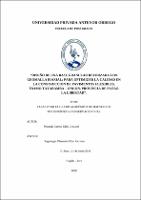Mostrar el registro sencillo del ítem
Diseño de una base granular reforzada con geomalla biaxial; para optimizar la calidad en la construcción de pavimentos flexibles, tramo Tayabamba - Ongón. Provincia de Pataz. La Libertad
| dc.contributor.advisor | Sagástegui Plasencia, Fidel Germán | |
| dc.contributor.author | Miranda Ramos, Eddy Cristiam | |
| dc.creator | Miranda Ramos, Eddy Cristiam | |
| dc.date.accessioned | 2019-07-03T17:26:13Z | |
| dc.date.available | 2019-07-03T17:26:13Z | |
| dc.date.issued | 2019 | |
| dc.identifier.uri | https://hdl.handle.net/20.500.12759/5061 | |
| dc.description.abstract | La presente investigación tuvo como principal objetivo evaluar el uso de la geomalla biaxial como refuerzo del pavimento flexible en la interfaz de la base y subbase aplicado en la carretera Tramo Tayabamba. Ongon. Provincia de Pataz. La Libertad. El procedimiento para realizar la evaluación fue diseñar la estructura del pavimento flexible sin refuerzo mediante el método de AASHTO 93 que requiere de un análisis de una serie de parámetros de los cual los más importantes son el diseño de tráfico y el cálculo del módulo de resilencia, este a su vez es obtenida a través del CBR que se determinó en los ensayos de laboratorio realizadas a la muestra de suelo extraída de la localidad, y a partir de este diseño se realizó dos diseños con dos tipos de geomalla de diferente resistencia, la geomalla biaxial LBO 202 que es de 20 KN y la geomalla LBO 302 que es de 30 KN, para ambos diseños se hizo mediante el método Geosoft Pavco V 3.0, esto con el fin de determinar los espesores de la base y subbase reforzada con la geomalla, además, se realizó los metrados para cada diseño obtenido con el objetivo de analizar los costos para cada escenario. La metodología utilizada para la investigación es de diseño experimental en un grado de manipulación de la variable independiente de presencia – ausencia, además, tiene un enfoque cuantitativo y por la orientación se define como una investigación aplicada. De la comparación realizada entre los tres diseños se obtuvo como resultado que la geomalla LBO 202 genera una disminución de 4% en la base y 43% en la subbase y la geomalla biaxial LBO 302 disminuye en un 8% la base y 50% la subbase la estructura del pavimento flexible, por otro lado, los costos se ven reducidos en un 2.31% y 3.73% respectivamente. | es_PE |
| dc.description.abstract | The main objective of the present investigation was to evaluate the use of the biaxial geogrid as a reinforcement for the flexible pavement at the interface of the base and subbase applied to the Tayabamba section road. Ongon. Province of Pataz. Freedom. The procedure to carry out the evaluation was to design the structure of the flexible pavement without reinforcement using the AASHTO 93 method, which requires an analysis of a series of parameters of which the most important are the traffic design and the calculation of the resilience module, This in turn is obtained through the CBR that was determined in the laboratory tests performed on the sample of soil extracted from the locality, and from this design two designs were made with two types of geogrid of different strength, the biaxial geogrid LBO 202 which is 20 KN and the LBO 302 geogrid which is 30 KN, for both designs was made by the Geosoft Pavco V 3.0 method, this in order to determine the thickness of the base and subbase reinforced with the geogrid, in addition , the measurements were made for each design obtained in order to analyze the costs for each scenario. The methodology used for the research is of experimental design in a degree of manipulation of the independent variable of presence - absence, in addition, it has a quantitative approach and by orientation is defined as an applied research. From the comparison made between the three designs, it was obtained that the LBO 202 geogrid generates a 4% decrease in the base and 43% in the subbase and the biaxial LBO 302 geogrid decreases the base by 8% and the subbase by 50% The structure of the flexible pavement, on the other hand, costs are reduced by 2.31% and 3.73% respectively. | en_US |
| dc.description.uri | Tesis | es_PE |
| dc.format | application/pdf | es_PE |
| dc.language.iso | spa | es_PE |
| dc.publisher | Universidad Privada Antenor Orrego - UPAO | es_PE |
| dc.relation.ispartofseries | T_MAEST.INGE_098 | |
| dc.rights | info:eu-repo/semantics/openAccess | es_PE |
| dc.source | Universidad Privada Antenor Orrego | es_PE |
| dc.source | Repositorio Institucional - UPAO | es_PE |
| dc.subject | Geomalla biaxial | es_PE |
| dc.subject | Base granular | es_PE |
| dc.subject | Pavimento flexible | es_PE |
| dc.title | Diseño de una base granular reforzada con geomalla biaxial; para optimizar la calidad en la construcción de pavimentos flexibles, tramo Tayabamba - Ongón. Provincia de Pataz. La Libertad | es_PE |
| dc.type | info:eu-repo/semantics/masterThesis | es_PE |
| thesis.degree.level | Maestría | es_PE |
| thesis.degree.grantor | Universidad Privada Antenor Orrego. Escuela de Postgrado | es_PE |
| thesis.degree.name | Maestro en Transportes y Conservación Vial | es_PE |
| thesis.degree.discipline | Maestría en Transportes y Conservación Vial | es_PE |

